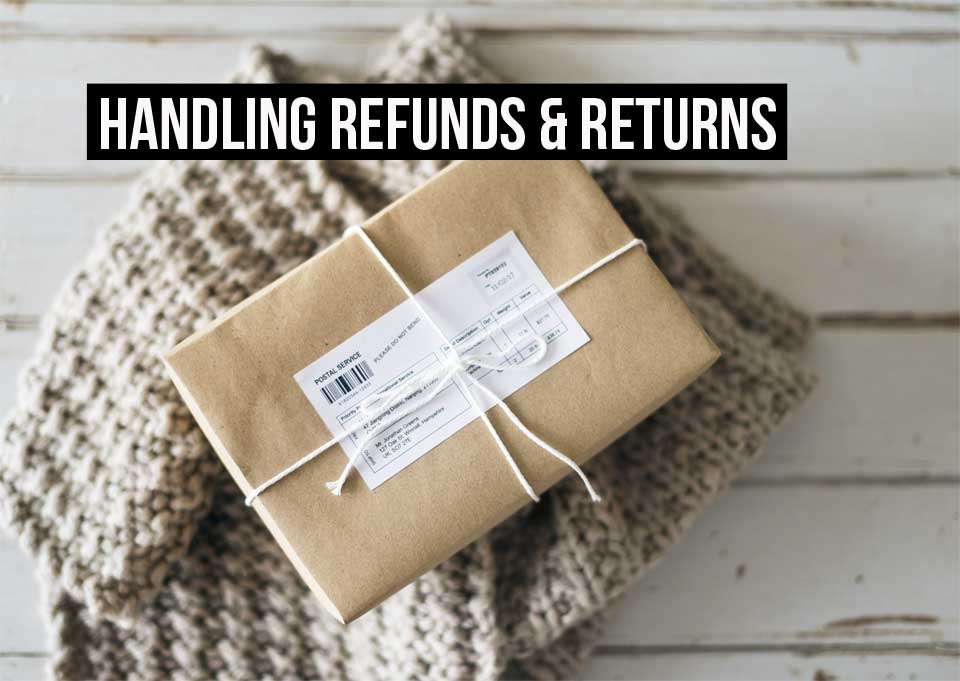It’s one of those inevitabilities when it comes to running a business. At some point, it’s more than likely that you’ll need to reimburse a customer. There are a few main situations that can lead to this, but the result is ultimately the same.
However, there are a number of things to consider and some steps to take depending on the particular situation and how you will be processing the refund.
One of the more important things to have in place even before you start making sales is a clear return policy. This will provide guidance not only to the customer but also to you in the event that a return is the cause for a refund request. More on this to come.

Do you have to provide a refund?
Under the Consumer Rights Act of 2015, customers have a right to a refund under certain circumstances. In these cases, yes, the customer is entitled to reimbursement, replacement, or repair of an item that falls under the situations outlined in the Act.
When and why refunds occur
The first time a customer requests a refund, you may find yourself with a pit in your stomach. But this is just par for the course. Things happen and people have different perspectives on things. But let’s take a look at some of the most common reasons refunds are requested:
Faulty product: sometimes in the production process, there might be a few items that are quite up-to-scratch with the quality of the items that your business sells. Although a clear quality check should occur, it is still possible that small issues can be missed. In this situation, a customer may request to return the product with a refund, or for a free replacement.
Product not as described: if the customer is expecting something of a particular size, colour, shape, etc. and believe that the product delivered does not match what was made clear on the website, for example, they may request a refund and should return the item.
Product doesn’t do what it should: different from a faulty product, this is when a product doesn’t function as it should for use.
Another circumstance in which customers may be entitled to a refund includes:
- Damaged product: this can be outside the control of the business, for example if the box containing the product becomes damaged in shipping and the product is compromised.
Under the Consumer Rights Act of 2015, customers have up to 30 days to request a refund from the date that the product is delivered. This does not apply, however, to downloaded digital content.
If the 30 day period has been passed, customers are still able to request a repair or a replacement. If the product develops a fault within the first 6 months, this stipulation applies.

How to handle refunds
There is a lot of advice out there for how to handle refunds. First and foremost, every refund situation should follow your return policy. This will ensure that you come across as professional and handle the situation as efficiently as possible.
Customer relationship and refunds
When it comes to returns and refunds, the situation can quickly become unpleasant, especially if the customer believes they have grounds and have not received positive treatment or if the product received was not what they expected.
In these cases, even when you may not agree with their opinion, it’s important to maintain a positive, helpful approach. People can even become rude in this process, so it’s important to maintain calm throughout. While it may be (more than) tempting to be rude right back, this generally only serves to worsen an already unpleasant situation.
Not only does it make the situation hopefully run a bit smoother to stay friendly and professional, it also likely reduces the chance for negative word of mouth on the part of the customer. For small businesses, it’s important that customers know that in dealing with you, they will receive professional, friendly treatment.
Perhaps most essential: make sure that the refund is processed and issued as quickly as possible.
Accounting & invoicing and refunds
On the accounting side of things, processing a refund or a partial refund should involve a credit note. The purpose of the credit note is to cancel the transaction and show in your accounts that the funds paid by the customer have been returned. The credit not allows both parties involved to reflect this in their accounts.
Credit notes can be issued for the full amount of an invoice, or for only a partial amount if, for example, a refund was only issued for one item line on the invoice, but not for others.
Credit notes are not used only in the case of refunds, but are also used to correct mistakes on invoices when pricing or tax is involved. Credit notes can effectively ‘cancel’ an invoice in the case that the sale is cancelled or does not go through.
Issuing a refund through Debitoor
When you create an invoice in Debitoor, creating a credit note is as simple as a few clicks. This credit note will be linked to the original invoice and show the credited amount. The actual transferring of funds will need to be done through your bank or payment solution, for example, as Debitoor does not actually handle any money.
Once you’ve issued the credit note, this will appear also on the customer’s account statement, and will be factored into your accounts, which means no more tedious double-entry bookkeeping.
With Debitoor accounting & invoicing software, the ledgers are built-in, making it even simpler to manage your invoicing and accounting from anywhere.
